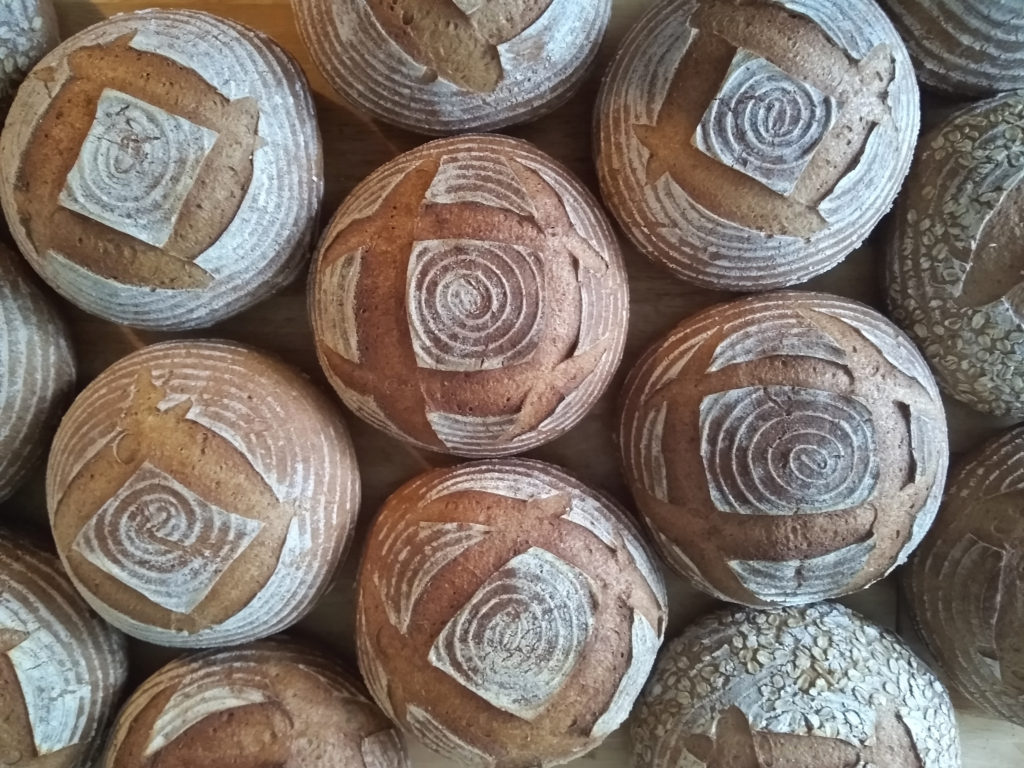Intro to Sourdough
Sourdough bread is bread that has been fermented and leavened with a naturally occurring, symbiotic culture of yeasts and lactobacillus bacteria. The yeasts and lactobacilli break down and consume sugars within the flour, and, in turn, secrete carbon dioxide and lactic acid. The secreted carbon dioxide then creates air pockets in the dough, causing it to rise, while lactic acid adds a depth of flavor, preservation qualities, and some notable health benefits.
Health benefits of sourdough
It is common for sourdough breads to ferment and rise over long periods of time. At room temperature, dough could take 2-12 hours before it is ready for baking. With cooler rising temperatures, fermentation can go on 36 hours or more. As the wild yeasts and lactobacilli ferment and leaven the dough over these longer periods, the grains become more digestible, and the vitamins, enzymes and nutrients become more available to us. In turn, we feel more satisfied after eating fermented bread, and avoid many of the negative side effects – heaviness, drowsiness, lethargy, etc. – we usually associate with conventionally prepared grains.
A brief history of Sourdough
Until the relatively recent invention of bakers yeast about 150 years ago, most leavened bread was technically sourdough bread. Our oldest evidence of fermented bread comes from excavations in Switzerland, which date to 3700 BCE, though educated speculation puts the more likely origin in the Fertile Crescent, several thousand years earlier. As the mircoflora responsible for the fermentation process are present almost everywhere – in the local environment, in and on our bodies, in the air, and on the grains themselves – it is reasonable to think that a mixture of flour and water was simply left out in a warm place longer than usual, causing it to ferment. The resulting bread would have been noticeably lighter and tastier than their usual hard flatbreads.

From this fortuitous moment, our ancestors began to explore the the flavoring, leavening and preserving qualities of fermented bread. Over the next several thousand years, the art of sourdough baking flourished, evolved, and greatly improved as different cultures brought their own skills, inspiration and locally available grains.
As our understanding and technology improved over time, we were eventually able to isolate favored strains of yeast, chosen for their ability to create large amounts of carbon dioxide and raise dough quickly. Favoring these quick-rising yeasts, we collectively left the lactic-acid producing lactobacilli, and their health benefits, behind. These yeasts strains were often propagated and sold in a slurry mixture of barley malt and wheat flour, and, in the 19th century, were further refined into pure yeast cakes. Finally, during World War II, a dried, granular yeast (Saccharomyces cerevisiae) was invented for the United States armed forces.
This new dried version did not require refrigeration as the old yeast cakes did, had a longer shelf life, and leavened dough faster than ever before. Because these new breads lacked the flavor, nutrition and preservation qualities of traditional sourdough, however, chemical preservatives and dough enhancers were also invented to make them more appealing. The ease, reliability and speed at which bread could now be made ushered the slow, unpredictable process of sourdough into the cultural background.
Today, however, these ancient traditions are reviving all over the world. Unsatisfied with the taste, quality and overall detriment to our health that industrialized bread provides, many bakers and families are returning to their roots. With a renewed connection to our ancestors and myriad health benefits, the ancient art of sourdough baking is quickly becoming the future of bread.
Gluten-free sourdough

While traditional sourdough bread is usually made with wheat flour, much of the practice is applicable to gluten-free baking. There are many, many gluten-free grains and seeds and many of them can be fermented and used for bread baking in exactly the same way as wheat. Buckwheat, millet, amaranth, oat, teff, rice, corn…the list goes on. Each grain and combination of grains creates its own flavor and texture profile – there is truly no end to the possibilities.
The most notable difference in gluten-free baking its obvious lack of gluten, and the structure gluten provides throughout the baking process. In contrast, gluten-free dough has almost no structure at all, and either needs a baking vessel and/or added ingredients to give it shape, such as flax, chia, psyllium and xanthan gum. Each option, and combination of options, can be useful depending on your own tastes, sensitivities and desired outcome.
